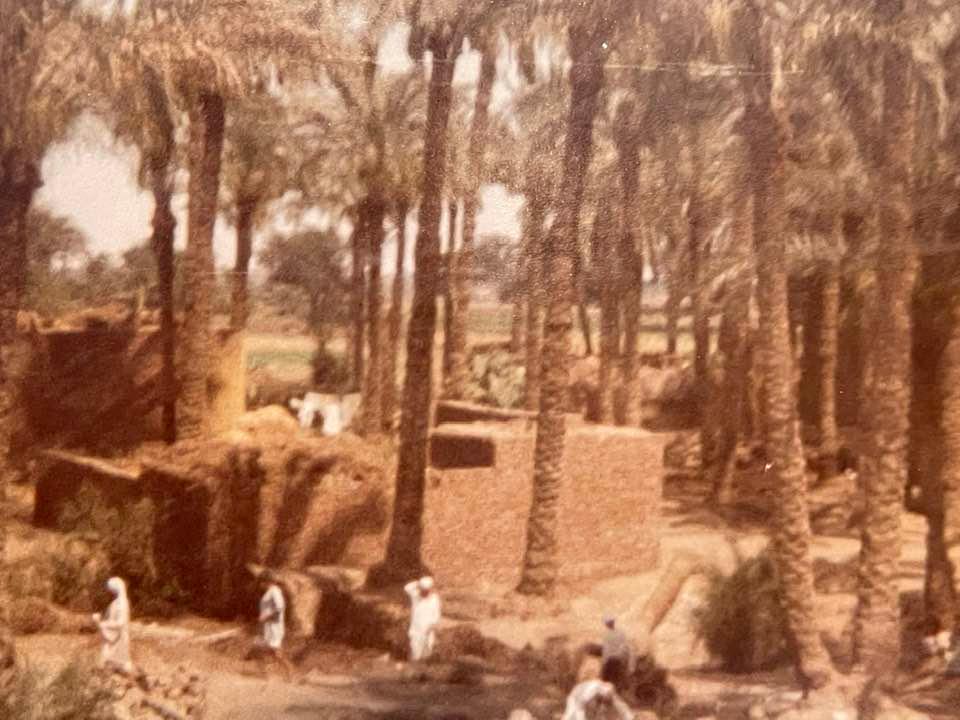MARCH 4, 2022 – In Cairo I visited with well-educated Egyptians over coffee and French pastries; stirred by curiosity, I haggled with perfume merchants in a district where every other car parked along the narrow street was a late model, high-end Mercedes; and famished for Western fare, I walked past the valets at the Ritz and splurged like a Pharaoh at the luxury buffet.
But modernity vanished into the oppressive Egyptian heat once the dirty, crowded, non-air-conditioned train to Luxor headed up the Nile River Valley. If my seat was hard, at least it was a seat—passengers on the rooftop had “air-conditioning” but no seats. Yet, much of the time I stood near a door opening—partially for air but mostly for a better view of the timeless countryside.
In a letter home I wrote, “[Rural Egypt] is still in the 10th century before Pharaoh. Donkeys and camels are the principal beasts of burden and form of transport. Houses are made exclusively of dried mud bricks, and the clothing looks Biblical. Well water is drawn by a water wheel “motored” by a donkey, and irrigation is accomplished with the manually operated Archimedes screw. Clothes and cooking utensils are ‘washed’ in sewage canals.”
My objective in Luxor was the Valley of the Kings—and many subjects of Professor Beam’s slides. Yet, most memorable was contemporary life immersed in the past. One encounter occurred on the outskirts of Luxor after my two Kiwi friends and I had spent the day exploring ancient monuments. Dragging ourselves through a sunbaked settlement, we approached a local for directions. His friendly countenance and smattering of English sparked a rapport, which led to an invitation for tea.
“We were invited into [his family’s] mud brick hovel,” I wrote, “and offered chai. We gladly accepted, curious to see ‘inner’ Egypt. The family was just as curious about us, and within moments after we were seated, the whole neighborhood was peering through the window openings and doorway. All were so friendly.”
Even in that remote setting, people were eager to express approval of the U.S., Carter, and the peace process between Israel and Egypt. Though clad in homespun clothes, their lives had been deeply affected by global geo-politics.
In my letter I commented on how the Soviet Union had altered ancient ways: “Without the Nile, life in Egypt would be impossible. Yet at no place (except the delta) is the ‘Nile Green’ wider than 20 kilometers. A major problem faced by Egypt is the Aswan Dam, engineered by the Soviets. First, according to an Egyptian engineer I met, the dam is poorly constructed and dangerous. Second, there is no longer an annual flood and thus, no more fertile silt. That requires dependence on artificial fertilizers, which eventually poison the soil, as well as the people. [T]he land fertilized with chemicals is less productive than it once was. The dam is Egypt’s biggest problem, and of course, the Soviets are not accountable.”
The more things change, the more they remain the same.
(Remember to subscribe to this blog and receive notifications of new posts by email.)
© 2022 by Eric Nilsson

1 Comment
Your adventure in Luxor recalled my own visit in the 70’s. The only tourists we saw were Russians who were being given vacations as part of a pay- back plan for help building Aswan Dam of which they were very proud at the time. Thank you for your recollections of your travels; they bring back fond memories for me. Keep remembering and healing. June
Comments are closed.